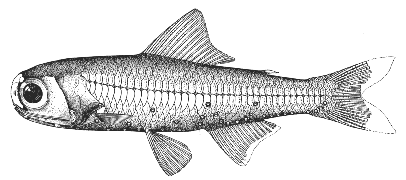Headlight fish Diaphus effulgens (Goode and Bean) 1895
[Jordan and Evermann, 1896-1900, p. 566.]

Figure 60.—Headlight fish (Diaphus effulgens), Browns Bank. From Goode and Bean. Drawing by A. H. Baldwin.
Description—
This curious little fish is separable from the lanternfish (p. 143) and from the pearlsides (p. 144) at a glance, by the large and very noticeable luminescent patch that covers the entire tip of its snout (including the anterior margin of the orbit) and that extends down over the edge of the upper jaw, a structure that has no parallel in any other fish regularly inhabiting the Gulf of Maine. It also differs from the pearlsides in its much more deeply cleft mouth, its even larger eyes, in the more convex dorsal profile of its head, and in lacking the regular horizontal row of luminescent spots along each side about at the level of the pectoral fin, that are conspicuous on the pearlsides.[26]
The four separate luminescent spots at the base of the tail (besides the organ on its snout) separate it from its close relatives of the genus Myctophum (p. 143). The arrangement of the fins (all of which are soft, the dorsal with about 15 rays, the anal with about 16), is essentially the same as in the latter, and in the pearlsides; the caudal fin is more deeply forked than in the pearlsides, the adipose fin proportionately shorter.
Color—
The color has not been described. Probably it is black, overlaid more or less with [page 143] silver, with the luminescent organs pale blue or green.
Size—
The specimens from which this species was originally described seem to have been about 7 inches long.[27]
General range and occurrence in the Gulf of Maine—
This oceanic species is only a stray within the limits of the Gulf. One specimen has been found in the stomach of a cod caught on Browns Bank,[28] and another, also from a cod stomach, has been reported on Western Bank off the outer coast of Nova Scotia.[29]
[26] The structures along the lateral line shown here on the illustration of the headlight fish are large scales, not luminescent organs.
[27] The illustration (Goode and Bean, Smithsonian Contrib. Knowl., vol. 30, 1895, fig. 103), about 6 inches long, is characterized in the legends "slightly reduced."
[28] Reported by Goode and Bean (Smithsonian Contrib. Knowl., vol. 30, 1895, p. 88) as Aethoprora effulgens.
[29] Vladykov, Proc. Nova Scotia Inst. Sci., vol. 19, 1935, p. 2.